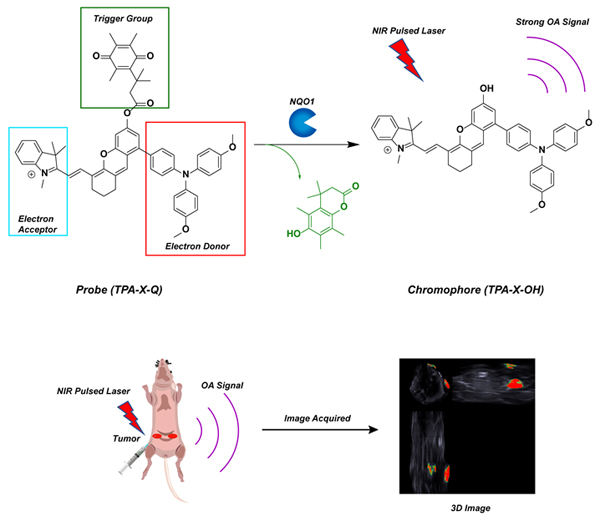摘要/Abstract

醌氧化还原酶(NQO1)是生物体内的一种双电子还原反应的专性催化还原酶. 在一些疾病如乳腺癌中NQO1过度表达, 因此NQO1可作为生物标志物以观察乳腺癌肿瘤的产生和发展. 目前已有一些文献报导用于NQO1检测和荧光成像的荧光探针, 但大部分这些探针具有吸收波长较短、背景干扰较强、组织穿透深度较低等不足. 为克服荧光探针成像的上述缺陷, 我们构建出一种具有推拉电子结构的可对NQO1响应的新型近红外光声探针TPA-X-Q. 实验结果表明, 该探针可在生物体内和体外对NQO1进行专一性的增强型光声检测和成像, 并可提供高分辨率的实时光声信号图像. 此外, 这种新型的光声探针能够成功应用于乳腺癌小鼠模型, 对乳腺癌肿瘤中过量表达的NQO1进行灵敏准确的光声检测与成像, 借助多光谱光声断层扫描技术(MSOT)的三维光声图像重建功能, 可实现肿瘤病灶区域的定位.
关键词: 醌氧化还原酶, 探针, 近红外, 乳腺癌, 多光谱光声断层扫描
NAD(P)H:quinone oxidoreductase-1 (NQO1) is a cytosolic two-electron-specific reductase whose abnormal expression is associated with breast cancer, and NQO1 has been regarded as an important biomarker for monitoring the occurrence and development of breast tumors. Although there are some research reports involving fluorescent probes for imaging NQO1 in vivo, they generally suffer from the strong light scattering by tissues which would cause the spatial resolution of fluorescent signals degrade rapidly with imaging depth. On the other hand, as an emerging detection and imaging modality, optoacoustic tomography (OAT) is capable of providing more detailed information in deep biological tissues than fluorescent imaging, since in OAT ultrasound signals are the reporting signals. To overcome the inherent defects of fluorescent imaging, in this work, we developed a novel near-infrared (NIR) NQO1-activatable optoacoustic (OA) probe TPA-X-Q based on the push-pull internal charge transfer (ICT) scaffold. TPA-X-Q consists of a NQO1-responsive moiety, quinone propionate group and a NIR chromophore TPA-X-OH. In the absence of the enzyme NQO1, the probe displays nearly no noticeable OA signal upon NIR excitation. Whereas in the presence of NQO1, the quinone propionate group of TPA-X-Q is reduced and cleaved by the enzymatic reaction triggered by NQO1, and thus TPA-X-Q is transformed into TPA-X-OH, consequently evident OA signal is generated, thereby realizing the detection and imaging of NQO1. As for the probe, the limit of detection (LOD) is determined to be 0.193 μg·mL –1. Furthermore, the probe TPA-X-Q displays several advantages, such as quite good selectivity towards NQO1, low cytotoxicity and excellent photostability. Moreover, the probe has been successfully utilized to detect and image the overexpressed NQO1 in the breast cancer-bearing mouse model. Orthogonal-view three-dimensional (3D) images can also be obtained by using multispectral optoacoustic tomography (MSOT), and thus precise localization of the breast cancer tumors can be achieved. This probe holds great potential for being employed as an efficacious tool for diagnosing breast cancer via responding to NQO1.
Key words: NQO1, optoacoustic probe, near-infrared, breast cancer, MSOT
PDF全文下载地址:
点我下载PDF
